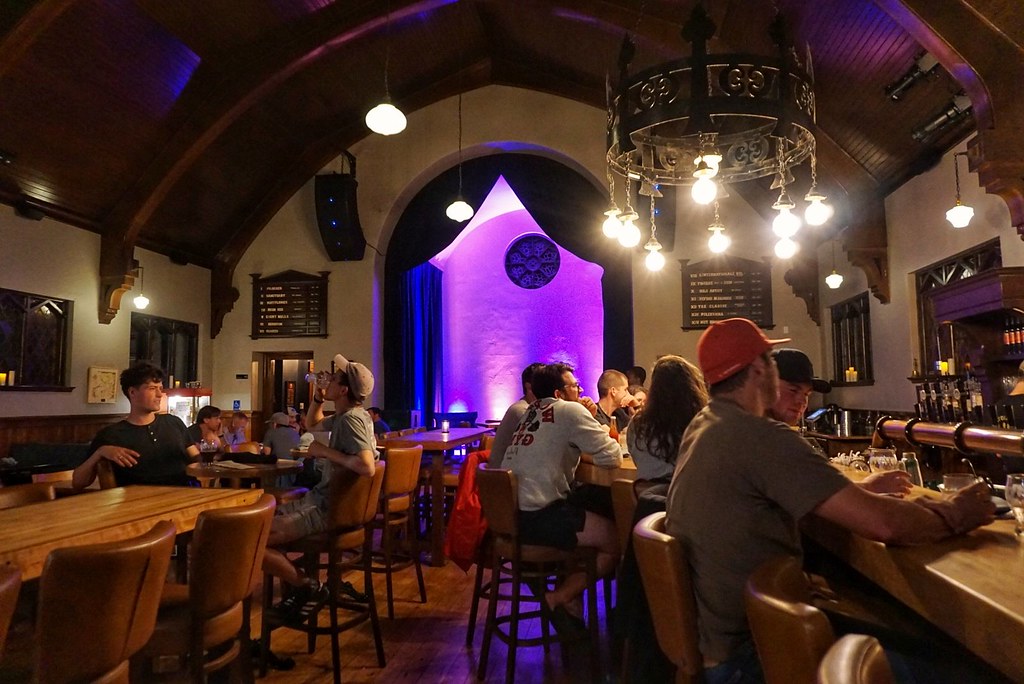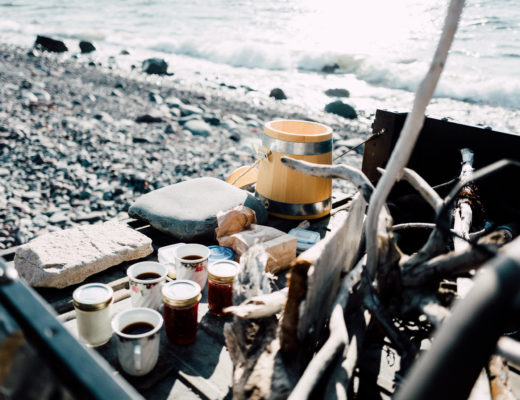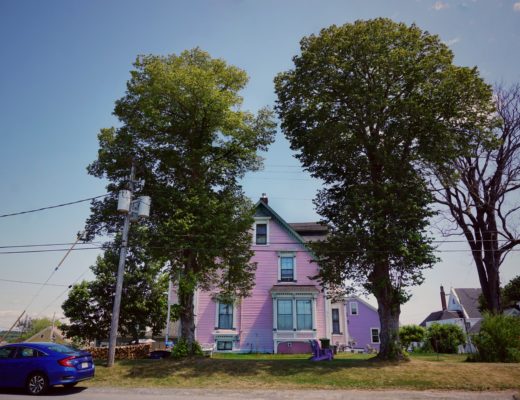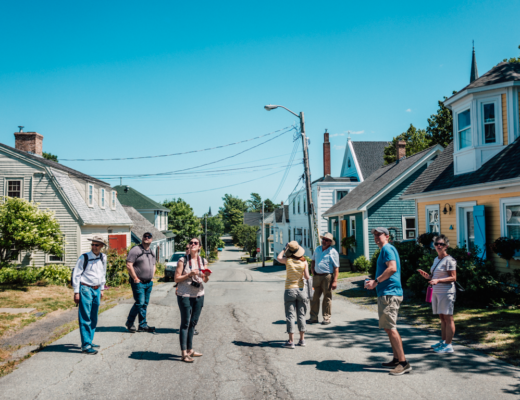I’d never been to the east coast of Canada before I road-tripped through it.
In fact, I’d never visited Canada at all – but I’d always wanted to. Up until a few weeks ago, Canada still existed in my mind as a maple-syrup-soaked land of giant moose and friendly locals: essentially, a stereotypical dream. And when the plan of road tripping along Canada’s east coast emerged, I envisioned a highway dotted with Tim Hortons, ice rinks and, again, giant moose.
But over the course of a fortnight, my photographer friend Kim and I drove along the open highways of Nova Scotia and Newfoundland & Labrador, searching for every story we could find – and the stereotypes fell away in favour of something better.
Our search for stories led us to riding ATVs through tall grass and foraging for cloudberries in soggy marshland. To jigging for cod on a tiny fishing boat, wrapped inside a blanket of fog. To kayaking in the Atlantic ocean alongside the bobbing heads of sleek-bodied seals. To walking with ghosts in darkened cemeteries with lost German names inscribed on slabs of broken slate. To rising earlier than the light and hiking past stone stacks at sunrise. To drinking tea from china cups beside beach bonfires and toasting each other with homemade scones and jam.
And then there were the people: a seemingly never-ending stream of Nova Scotians and Newfoundlanders who are, truly, some of the most immediately friendly strangers I’ve ever met.
But the road was the central thread of this journey: following those painted strips of yellow line vanishing beneath our car tyres, the constant banks of trees broken up by a succession of unfamiliar names on roadsigns, and an ever-present stretch of asphalt winding out like a ribbon before us. And it also acting like a framework, allowing us to get to grips with Atlantic Canada from a fascinating perspective.
Here’s what we learned from a two week road trip across east coast Canada.
Pin me for later!
Atlantic Canada will remind you of a dozen different places.
The east coast of Canada is comprised of four provinces: Nova Scotia, Prince Edward Island (PEI), New Brunswick and Newfoundland & Labrador. Those first three are also called the Maritime provinces – the easternmost province of Newfoundland & Labrador only joined Canada in 1949, so it’s not included in that grouping.
These Atlantic provinces are clearly influenced by the different cultures of people who settled here – Scottish, Irish, English and French – along with the First Nations who have always called this part of Canada home. You’ll see these different cultures reflected in people’s accents, surnames, and names of locations: like the Irish brogue of Newfoundlanders, or the signs to places like Lower Shoal Highway, Little Heart’s Ease and Bear Nation River.
The landscapes are like Ireland and Scotland…
In Nova Scotia, we often mentioned we’d be visiting Newfoundland & Labrador next – and everyone said the same thing: that Newfoundland was exactly like Ireland.
This island province has the most stunning landscapes: wide sweeps of coastal cliffs, deep stretches of pockmarked earth, and sudden forests under vast expanses of sky. Fascinatingly, Newfoundland & Labrador is home to some of the oldest fossils on the planet, thanks to its history as a place where the continental plates collided.
… But the buildings look like they’re lifted from northern Norway.
Every time we passed one of the tiny fishing huts (called ‘stages’) which are dotted along Atlantic Canada’s coastline, I continually thought of the similar little red-roofed buildings in northern Norway.
It always makes me happy to draw parallels between two different parts of the world – and it makes sense in this case. Both Atlantic Canada and Arctic Norway rely heavily on fishing, hence why they position their buildings right above the water.
There aren’t many cars, and the road is often empty.
For long stretches of our driving days in both Nova Scotia and Newfoundland, we were treated to virtually empty roads. On the plus side, this meant maximum views of the surrounding landscape – but on the downside, we couldn’t play as many car games prompted by the vehicles around us (a firm favourite of mine is guessing what kind of person is driving based on their numberplate letters).
Luckily, Kim was treated to my second-favourite car game: the alphabet-based “I went to the supermarket” – except with a Canadian theme. This game pulled us through about two hours of driving at the end of our trip, along with a serious case of hysteria…
Your car snacks will all include maple in some form.
All good road trips need an assortment of local snacks for munching on. Keep a box of maple biscuits in the car for emergencies (along with some maple butter cereal bars for real emergencies).
The weather can change in an instant (especially in Newfoundland!)
Dressing for weather in the Maritime provinces is an education. We had constant blue skies and bright sunshine in Nova Scotia, but on arrival in Newfoundland our plane touched down in a thick soup of heavy fog.
Newfoundland is famed for its quick-to-change weather, thanks to the contrast with sea and air temperatures. The fog comes out of nowhere – but it can also fade away again pretty quickly.
Sadly, there’s a fair amount of roadkill.
In Nova Scotia, there were multiple occasions when I suddenly shouted, “Raccoon!” “Possum!” “Ohh… it’s a porcupine..!”
Seeing a little pile of upended quills perhaps isn’t the best way to see my first ever porcupine in the wild: unfortunately the highway is a dangerous spot for many Canadian animals, and it’s often the last resting place for the aforementioned critters – along with snakes, groundhogs and skunks.
Thankfully I was much happier in Newfoundland, as there’s barely any roadkill to be seen.
Luckily there’s also plenty of Canadian wildlife that’s alive and well!
It’s extremely tantalising to know that the forests on either side of the road could be filled with brown bears and moose (even if they’re hiding from view whenever you look). But there’s lots of other animals happily enjoying life in Atlantic Canada.
On our kayaking adventures in Blue Rocks, Nova Scotia, we watched the seals swim, surface and dunk themselves beneath the water again, and during a boat tour in New Bonaventure, Newfoundland, I saw my first ever bald eagle sat in the top of a far-off tree – which then took off in flight right in front of us. All my photos are way too blurry but I was so happy!
But the best wildlife sighting has to be in Elliston, NL, where an entire rock’s surface is covered in puffins. We sat on the rain-soaked grass and time seemed to stop as we watched these adorable little birds zoom around – and eventually a pair decided to land right in front of us. At the same moment, there were three or four whales in the ocean just beyond, their bodies and bursts of bubbles repeatedly appearing above the water’s surface.
I could have sat there all day long.
You’ll want to see moose – but also you DON’T want to see moose.
My not-so-secret predominant wish for our Canada trip was to see a moose casually mooching along the highway as we drove past. Kim, who was coincidentally doing all the driving, was not so keen. Particularly when I showed her this viral video of a moose in Alaska.
We didn’t end up seeing any moose in the end – and I’m actually quite grateful, because these guys are no joke.
Searching for coffee shops with espresso machines can lead you to some adorable cafes…
On a roadtrip, a caffeine hit in the mornings is basically mandatory – so Kim and I made it our mission to sample good coffee wherever we went. We’ve both spent our adulthoods drinking espresso coffee, but in the more rural parts of Atlantic Canada (particularly in Newfoundland) it proved quite difficult to find coffee shops which served cappuccinos and lattes.
Don’t give up the search though! Our need for caffeine often led us to some lovely places – like The Two Whales Coffee Shop in Port Rexton, NL, the Laughing Whale Coffee Roasters in Lunenberg, NS, and T.A.N. Coffee in Windsor, part of an alternative coffee shop chain in Nova Scotia.
… But you will inevitably find yourself inside a Tim Hortons.
Tim Hortons is a quintessentially Canadian chain and there are thousands of Tim Hortons stores across Canada. We automatically tried to avoid them in pursuit of the aforementioned independent coffee shops – but one foggy morning it was the only place serving coffee for miles around.
I’m glad we ended up there, because it turns out the coffee is pretty damn good. And the Timbits (delicious bite-sized doughnut holes in all kinds of flavours) aren’t to be sniffed at, either.
Sampling Canada’s fast food chains is a worthy endeavour.
If you’re going to try the Timbits from Tim Hortons, then you also need to try Canada’s other fast food offerings.
On our first day in Halifax we went straight to a poutine shop, sharing a box filled with chips smothered in cheese curds, pulled pork and gravy. It was sinfully delicious – and within 24 hours we’d also made our way to BeaverTails.
Inspired by Canada’s unofficial mascot animal, this pastry shop makes Canadian doughnuts and pastries, including their hand-stretched doughy namesake. I sampled a beavertail-wrapped hot dog while walking along the Halifax waterfront and it was way too tasty for its own good.
You could feasibly eat fresh lobster for every meal…
When dinnertime rolls around in Atlantic Canada, there’s always lobster in some format on the menu. Lobster poutine, lobster mac & cheese, lobster rolls, the infamous ‘Lunenburger’ (a beef burger topped with lobster and a scallop, served in its namesake town of Lunenburg, NS), lobster tagliatelle, or the pièce de résistance — an entire lobster.
If you have lunch at Hall’s Harbour Lobster Pound in the Bay of Fundy you’ll get the chance to meet Lowell, who gives you a behind-the-scenes tour of the lobster pound and regales you with fascinating lobster facts while wearing beautifully themed lobster socks.
Lowell will also introduce you to the biggest (live) lobster you’ve ever seen: he’s called Albert, and his claw is bigger than Lowell’s foot.
Or you can just stuff yourself with seafood.
I’ve spent the last few years trying to give up most meat, but I still fail miserably at avoiding seafood. Being pescatarian feels more acceptable when you’re right beside the ocean – so I full-on indulged. After two weeks of delicious seafood at every meal, I don’t think I can eat mussels, scallops, or chowder again for a while…
In Atlantic Canada, the word ‘fish’ always means ‘cod’.
The importance of cod in Canada’s history cannot be overstated. Once the most-fished-for fish in the country because it was so plentiful, decades of over-fishing eventually led to a ‘cod moratorium’ in 1992, which banned cod fishing throughout Canada.
It was the biggest fisheries collapse in world history: it put over 40,000 people out of work overnight, decimated hundreds of coastal communities and irreparably changed the social landscape of east coast Canada, particularly in Newfoundland.
Almost thirty years later, Atlantic cod isn’t extinct but it’s still officially vulnerable. The government have now allowed the recreational fishing of cod but the fishery as an industry remains closed.
If you visit Newfoundland & Labrador, prepare to kiss the cod. Seriously.
This province have taken their love of cod to a whole new level: it’s a crucial part of a tradition called the ‘Screech-in’ which welcomes visitors to the island.
On our third night in St John’s (and after a number of pints at the Yellowbelly Brewery), our blogger friend Candice took us to George Street for our official screech-in ceremony. We stood in a circle amongst a bunch of other visitors while a giant of a man dressed in fisherman’s gear slapped a huge wooden paddle against his flattened palm and shouted out lines of a poem, which we had to shout back in repetition.
One by one we kneeled down, then kissed a frozen cod held in front of us – which was swiftly followed by downing a shot of Screech rum. And just like that, we were honorary Newfoundlanders!
There are huge lighthouses all along the coast…
If you love lighthouses, you’re in luck. Atlantic Canada is famed for its lighthouses, and there’s even an easily-followable lighthouse route along the Nova Scotia coastline.
We stopped in at a fair few lighthouses during our trip, including the famed Peggy’s Point Lighthouse at Peggy’s Cove, just outside of Halifax. The Nova Scotia Lighthouse Preservation Society has a comprehensive list of which lighthouses are open to the public (including a few where you can spend the night!)
View this post on Instagram
…and you’ll see much smaller lighthouses too.
Miniature lighthouses seemed to be a typically Canadian thing which I didn’t quite understand, but was nonetheless totally happy about (particularly when I asked Google, “‘why does Canada love lawn lighthouses’ and found this guy).
We passed multiple houses with tiny lighthouse statues set on their front lawns – and when they also featured Canadian flags it was even better.
You’ll see the same outdoor deckchairs everywhere you look.
Adirondack chairs are perhaps my favourite discovery from the east coast of Canada. When I first spotted them along the Halifax waterfront I assumed they were only a city-wide thing, but we quickly realised that these wide colourful deckchairs are all over the place.
I’ve tried to learn their origin and why Canada loves them so much, but the best info I could come up with was this: to celebrate Canada’s 150th anniversary in 2017, Parks Canada placed 150 all-weather Adirondack chairs across the country in an effort to connect Canadians with nature.
Adirondack chairs are usually in pairs of two or groups of three. We saw them on the front porches of hotels and private homes, at the ends of docks and beside lakes – even on hiking trails – and the ultimate reward was scoring a pair of chairs at Halifax airport on our five hour layover before flying back to London!
There’s a maritime museum in almost every town…
The east coast of Canada has a rich maritime history, and they’re doing a great job of informing visitors about it.
If you’re anything like me, you’ll love wandering through rooms filled with old anchors, paddle boats, buoys and dinghies, fascinating metallic artefacts made from metal and material and wood, along with dozens of crinkled photographs depicting sailors and captains from days gone by.
My favourites were the Maritime Museum of the Atlantic in Halifax, which had an entire floor dedicated to artefacts from the Titanic sinking (Halifax was the closest port to the sinking so many of the victims were brought here for burial) and the Provincial Seaman’s Museum in Grand Banks, Newfoundland, which featured a dozen different hearses on sledge blades – used when the water froze over in the 1800s.
… And there are even more cemeteries…
Atlantic Canada’s relationship to death is prominent, which makes sense when you think how many generations of fishing and sailing families have lost their loved ones to the sea. That prominence is reflected in where they choose to bury their dead, with cemeteries placed in centralised locations in pretty much every place we visited.
When we spoke to Pat Redgrave, the owner of The Garrison Inn in Annapolis Royal, NS – which sits opposite one of Canada’s oldest cemeteries with headstones dating back to 1720 – he said that in a part of the world where young fishermen often die, it’s not really possible to ignore death. As a result, the prevailing attitude of Nova Scotians and Newfoundlanders towards death seems pretty accepting.
…Which means there are ghosts (and ghost stories) everywhere.
The folklore and legends of Atlantic Canada are well-renowned – perhaps because this part of Canada has more decades of documented history than most of North America, but also because rich oral traditions are commonplace here.
Ghost walks, cemetery tours, spooky tales of hotel hauntings and faded old photos will all do their best to creep you out. I absolutely love this stuff. Kim? Not quite so much. Just outside a cemetery on our late night ghost walk through Lunenburg, NS, I made her scream when I sidled up to her to whisper, “There’s a man in that car…”
Turned out the creepy figure sat in the driver’s seat was a real human man just there to use the free outdoor wifi. It was still hilarious.
You’ll find yourself following local superstitions.
After hearing enough tales of century-old traditions and superstitious behaviour, it’s likely you’ll start following along with some of it.
During our ghost tour in Lunenburg, we learned that generations of Lunenburgers have spat on the ground when they see a single crow (which indicates bad luck) in order to beckon in a second crow (which lifts that bad luck). The next day while driving, we saw our third single crow of the day…. and both rolled down our windows to spit.
You don’t want to tempt bad luck, after all…!
If you’ve got a question, just look for the question marks.
There’s a lot of questions you can ask in eastern Canada – and thankfully the provinces are prepared for it. That’s why they’ve marked out their tourist offices with giant question marks, along with question-marked highway signs indicating you’re about to get the chance to ask some questions!
The first time we saw a question mark sign we erupted into laughter. But that could also have been roadtrip-related hysteria.
You can enjoy a rather tasty glass of local wine in Nova Scotia.
People told us that the vineyards in Nova Scotia produce wine that can rival France and California! Apparently the province’s soil and climate are perfect for growing grapes – and with more than eighteen wineries and vineyards dotted throughout Nova Scotia (particularly in Annapolis Valley), it’s becoming a burgeoning industry.
We sampled a few different red wines during our week in Nova Scotia and loved them. My favourite? The ‘Great Big Friggin’ Red’, complete with a label which reminded me of the circus.
Craft beer in Atlantic Canada is pretty fantastic too.
Aside from wine production, they’re also pretty hot on their craft beer in Atlantic Canada. There are dozens of craft breweries which made this IPA drinker very happy – I particularly liked the Garrison Tall Ship IPA and the Quidi Vidi ‘Day Boil’ Session IPA.
We spent time sampling beers at the Yellowbelly Brewery in St Johns and the nearby Quidi Vidi Brewery, but our favourite discovery was a brand-new bar set inside an old church in Wolfville, Nova Scotia (aptly named ‘Church’) with an ever-changing menu of locally brewed craft beer.
The sunrises are stunning – if you manage to wake up early enough.
The east coast of Canada is privy to some spectacular sunrises, which you’ll often vow to see. Unfortunately, you’ll often miss them because you were having too much fun the night before! But when you finally manage it (on the last morning of your trip..!) it’ll be beautiful.
We roused ourselves from a peaceful slumber in the insanely comfy beds at The Fisher’s Loft Inn in Port Rexton, Newfoundland, to head out on the Skerwink Trail at 5am. With fresh dew on the leaves and skittering bugs around us, we walked along the cliff edge beside the sea stacks and watched the sky change colour with the rising sun.
The best part of an east coast Canada road trip? Everyone will make friends with you.
Perhaps my favourite part of Atlantic Canada was making friends with people. It was absurdly easy, and yet still felt so special.
We struck up conversation with a woman and her family while queuing for our rental car at Halifax airport, then spent the early hours of the morning with a group of twenty-somethings that night at a local bar. An elderly married couple approached us at dinner with recommendations of where to visit in Nova Scotia; a young wife talked with me at length about Canada’s indigenous history while we went fishing; and a random woman tied my plastic bib behind my neck before showing me how to eat the lobster on the table in front of me!
There is no doubt that I’ll come back to Canada. There are two more Atlantic provinces I’ve yet to explore – and a hundred more stories to hear and to tell…
Would you go on an east coast Canada road trip? Are there any typical road trip lessons I’ve missed out?
Pin this article if you enjoyed it!
Disclaimer: This trip was in collaboration with Tourism Nova Scotia and Newfoundland & Labrador, who hosted Kim and I – but the opinions about Canadian superstitions, giant moose and Adirondack deckchairs are all my own.



























9 Comments
Bojy
August 29, 2019 at 11:44 amThis trip looks like a dream, I would love to visit Canada!
Flora
September 17, 2019 at 4:32 pmThanks Boj! It’s such a stunning part of the world 🙂
Steven Pickard
August 29, 2019 at 3:41 pmGlad you enjoy East Coast Canada. You just had to roll down your windows to spit to prevent bad luck is hilarious! Always enjoy
yours adventures.
Flora
September 18, 2019 at 11:12 amThanks so much Steven! The spitting was a highlight of the trip for both of us :p
Sherita Cox
August 29, 2019 at 5:17 pmFunny. I’m in St. Anthony, Newfoundland today. Did my screech-in a few weeks ago whilst in Cornerbrook. Great place. Especially loved Cape Spear outside of St. John’s.
Flora
September 18, 2019 at 11:13 amAhh that’s amazing Sherita! I’d have loved to experience a screech-in elsewhere in the province to see how it differed to St Johns. Hope you’ve been having a fantastic time in Newfoundland!
Sarah Dewar
October 7, 2019 at 9:52 pmHey Flora – I’m glad you finally made it to Canada. I lived on the East Coast for four years – I miss it a LOT. Your posting brought back so many good memories. Thanks.
Befriending the Locals in Lunenburg, Nova Scotia
September 12, 2020 at 9:00 am[…] next morning, we grabbed our bags and hit the road with only marginally aching heads for day one of our road trip through the province. I had Cameron’s hand-drawn map open in my notebook, his squiggly line leading us from Halifax […]
Nigel
October 9, 2022 at 5:18 amAha – didn’t think I’d find much here, having been born and raised in Canada and spending several years on the East Coast but this post certainly revitalized my early 20s and the fond memories I had.
I also never realized how hilarious it is that we send people hunting for question mark blocks (a la Super Mario?) when they need help. Thanks for that!
Oh, and for what it’s worth. Nice Canadians can be found everywhere, but the highest concentrations are certainly to be found on either coast and in the Maritimes. One might be forgiven if they were to pass through most of Ontario and the Prairies. Quebec is something else entirely, a bit like travelling to a different country even for a Canadian. Dunno if you ever made it back here or not, but Quebec is the only place where I’ve had gas station attendants pretend not to speak English just to inconvenience me, only to hear them making a crack to their coworker en Anglais when I left the store.